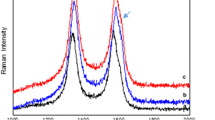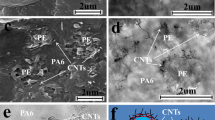Abstract
Enhancing the thermal conductivity (λ) of composites by establishing an effective thermally conductive path is the key to prepare thermally conductive composites. In this study, a new preparation method was used to achieve high λ of composites with low filler contents. Firstly, multi-walled carbon nanotubes (MWCNT) and alumina (Al2O3) established a synergistic thermal conductivity network in the polystyrene particles, and subsequently, the hexagonal boron nitride (h-BN) filler wrapped in the outer layer of the composite particles constructed a continuous h-BN thermal conductivity network during the hot-pressing process. The three-dimensional thermal conductivity network supported by the two thermal conductivity networks provided more pathways for heat transfer in the composite, thus significantly improving its λ. The λ of the composites increased to 3.36 W/mK for MWCNT content of 0.5 wt%, Al2O3 content of 0.5 wt%, and h-BN content of 30 wt%. The composite also has good insulating properties, with a conductivity value of only 3.21 × 10−9 S/cm at an h-BN content of 30 wt% and MWCNT content of 0.5 wt%. This results from the presence of a h-BN insulation layer on the outside of the composite sphere and the presence of Al2O3 in the synergistic network that blocks the electron transport inside the material, thus maintaining its good insulating properties. Therefore, the composite prepared in this paper has the potential to be used in the field of electronic packaging.








Similar content being viewed by others
Change history
01 August 2023
A Correction to this paper has been published: https://doi.org/10.1007/s42114-023-00724-2
References
Tan C, Zhu H, Ma T et al (2019) A stretchable laminated GNRs/BNNSs nanocomposite with high electrical and thermal conductivity. Nanoscale 11:20648–20658. https://doi.org/10.1039/c9nr06060j
Wang X, Wu P (2018) Melamine foam-supported 3D interconnected boron nitride nanosheets network encapsulated in epoxy to achieve significant thermal conductivity enhancement at an ultralow filler loading. Chem Eng J 348:723–731. https://doi.org/10.1016/j.cej.2018.04.196
Su Z, Wang H, He J et al (2018) Fabrication of thermal conductivity enhanced polymer composites by constructing an oriented three-dimensional staggered interconnected network of boron nitride platelets and carbon nanotubes. ACS Appl Mater Interfaces 10:36342–36351. https://doi.org/10.1021/acsami.8b09703
Cho H-B, Nakayama T, Suematsu H et al (2016) Insulating polymer nanocomposites with high-thermal-conduction routes via linear densely packed boron nitride nanosheets. Compos Sci Technol 129:205–213. https://doi.org/10.1016/j.compscitech.2016.04.033
Zhang X, Dong J, Pan D et al (2021) Constructing dual thermal conductive networks in electrospun polyimide membranes with highly thermally conductivity but electrical insulation properties. Adv Compos Hybrid Mater. https://doi.org/10.1007/s42114-021-00335-9
Ma H, Tian Z (2018) Chain rotation significantly reduces thermal conductivity of single-chain polymers. J Mater Res 34:126–133. https://doi.org/10.1557/jmr.2018.362
Zhu B, Liu J, Wang T et al (2017) Novel polyethylene fibers of very high thermal conductivity enabled by amorphous restructuring. ACS Omega 2:3931–3944. https://doi.org/10.1021/acsomega.7b00563
Bai L, Zhao X, Bao R-Y et al (2018) Effect of temperature, crystallinity and molecular chain orientation on the thermal conductivity of polymers: a case study of PLLA. J Mater Sci 53:10543–10553. https://doi.org/10.1007/s10853-018-2306-4
Lu C, Chiang SW, Du H et al (2017) Thermal conductivity of electrospinning chain-aligned polyethylene oxide (PEO). Polymer 115:52–59. https://doi.org/10.1016/j.polymer.2017.02.024
Yang N, Xu C, Hou J et al (2016) Preparation and properties of thermally conductive polyimide/boron nitride composites. RSC Adv 6:18279–18287. https://doi.org/10.1039/c6ra01084a
Fu C, Yan C, Ren L et al (2019) Improving thermal conductivity through welding boron nitride nanosheets onto silver nanowires via silver nanoparticles. Compos Sci Technol 177:118–126. https://doi.org/10.1016/j.compscitech.2019.04.026
Li Z, Kong J, Ju D et al (2017) Thermal conductivity enhancement of poly(3-hydroxylbutyrate) composites by constructing segregated structure with the aid of poly(ethylene oxide). Compos Sci Technol 149:185–191. https://doi.org/10.1016/j.compscitech.2017.06.028
Shen X, Wang Z, Wu Y et al (2018) A three-dimensional multilayer graphene web for polymer nanocomposites with exceptional transport properties and fracture resistance. Mater Horiz 5:275–284. https://doi.org/10.1039/c7mh00984d
Jia Y, He H, Geng Y et al (2017) High through-plane thermal conductivity of polymer based product with vertical alignment of graphite flakes achieved via 3D printing. Compos Sci Technol 145:55–61. https://doi.org/10.1016/j.compscitech.2017.03.035
Pan D, Dong J, Yang G et al (2021) Ice template method assists in obtaining carbonized cellulose/boron nitride aerogel with 3D spatial network structure to enhance the thermal conductivity and flame retardancy of epoxy-based composites. Adv Compos Hybrid Mater 5:58–70. https://doi.org/10.1007/s42114-021-00362-6
Diaham S, Saysouk F, Locatelli M-L et al (2015) Thermal conductivity of polyimide/boron nitride nanocomposite films. J Appl Polym Sci 132:n/a-n/a. https://doi.org/10.1002/app.42461
Xie Y, Yang Y, Liu Y et al (2021) Paraffin/polyethylene/graphite composite phase change materials with enhanced thermal conductivity and leakage-proof. Adv Compos Hybrid Mater 4:543–551. https://doi.org/10.1007/s42114-021-00249-6
Li X, Feng Y, Chen C et al (2018) Highly thermally conductive flame retardant epoxy nanocomposites with multifunctional ionic liquid flame retardant-functionalized boron nitride nanosheets. J Mater Chem A 6:20500–20512. https://doi.org/10.1039/c8ta08008a
Guo Y, Xu G, Yang X et al (2018) Significantly enhanced and precisely modeled thermal conductivity in polyimide nanocomposites with chemically modified graphene via in situ polymerization and electrospinning-hot press technology. J Mater Chem C 6:3004–3015. https://doi.org/10.1039/c8tc00452h
Cui J, Zhou S (2018) Facile fabrication of highly conductive polystyrene/nanocarbon composites with robust interconnected network via electrostatic attraction strategy. J Mater Chem C 6:550–557. https://doi.org/10.1039/c7tc04752e
Zou D, Huang X, Zhu Y et al (2019) Boron nitride nanosheets endow the traditional dielectric polymer composites with advanced thermal management capability. Compos Sci Technol 177:88–95. https://doi.org/10.1016/j.compscitech.2019.04.027
Bai Y, Shi Y, Zhou S et al (2021) A concurrent enhancement of both in‐plane and through‐plane thermal conductivity of injection molded polycarbonate/boron nitride/alumina composites by constructing a dense filler packing structure. Macromol Mater Eng 306. https://doi.org/10.1002/mame.202100267
Pan D, Yang G, Abo-Dief HM et al (2022) Vertically aligned silicon carbide nanowires/boron nitride cellulose aerogel networks enhanced thermal conductivity and electromagnetic absorbing of epoxy composites. Nano-Micro Lett 14:118. https://doi.org/10.1007/s40820-022-00863-z
Guo Y, Lyu Z, Yang X et al (2019) Enhanced thermal conductivities and decreased thermal resistances of functionalized boron nitride/polyimide composites. Compos Pt B-Eng 164:732–739. https://doi.org/10.1016/j.compositesb.2019.01.099
Fu C, Li Q, Lu J et al (2018) Improving thermal conductivity of polymer composites by reducing interfacial thermal resistance between boron nitride nanotubes. Compos Sci Technol 165:322–330. https://doi.org/10.1016/j.compscitech.2018.07.010
Xiao Y-j, Wang W-y, Lin T et al (2016) Largely enhanced thermal conductivity and high dielectric constant of poly(vinylidene fluoride)/boron nitride composites achieved by adding a few carbon nanotubes. J Phys Chem C 120:6344–6355. https://doi.org/10.1021/acs.jpcc.5b12651
Gu J, Liang C, Dang J et al (2016) Ideal dielectric thermally conductive bismaleimide nanocomposites filled with polyhedral oligomeric silsesquioxane functionalized nanosized boron nitride. RSC Adv 6:35809–35814. https://doi.org/10.1039/c6ra04513h
Wu Z, Cui H, Chen L et al (2018) Interfacially reinforced unsaturated polyester carbon fiber composites with a vinyl ester-carbon nanotubes sizing agent. Compos Sci Technol 164:195–203. https://doi.org/10.1016/j.compscitech.2018.05.051
Jing X, Li Y, Zhu J et al (2022) Improving thermal conductivity of polyethylene/polypropylene by styrene-ethylene-propylene-styrene wrapping hexagonal boron nitride at the phase interface. Adv Compos Hybrid Mater. https://doi.org/10.1007/s42114-022-00438-x
Xu F, Bao D, Cui Y et al (2021) Copper nanoparticle-deposited graphite sheets for highly thermally conductive polymer composites with reduced interfacial thermal resistance. Adv Compos Hybrid Mater. https://doi.org/10.1007/s42114-021-00367-1
Sun B, Huang X (2021) Seeking advanced thermal management for stretchable electronics. NPJ Flex Electron 5:12. https://doi.org/10.1038/s41528-021-00109-9
Ma J, Shang T, Ren L et al (2020) Through-plane assembly of carbon fibers into 3D skeleton achieving enhanced thermal conductivity of a thermal interface material. Chem Eng J 380:122550. https://doi.org/10.1016/j.cej.2019.122550
Zhou Y, Liu F, Wang H (2017) Novel organic-inorganic composites with high thermal conductivity for electronic packaging applications: a key issue review. Polym Compos 38:803–813. https://doi.org/10.1002/pc.23641
Yan H, Dai X, Ruan K et al (2021) Flexible thermally conductive and electrically insulating silicone rubber composite films with BNNS@Al2O3 fillers. Adv Compos Hybrid Mater 4:36–50. https://doi.org/10.1007/s42114-021-00208-1
Dong J, Cao L, Li Y et al (2020) Largely improved thermal conductivity of PI/BNNS nanocomposites obtained by constructing a 3D BNNS network and filling it with AgNW as the thermally conductive bridges. Compos Sci Technol 196:108242. https://doi.org/10.1016/j.compscitech.2020.108242
Yao Y, Sun J, Zeng X et al (2018) Construction of 3D skeleton for polymer composites achieving a high thermal conductivity. Small 14:e1704044. https://doi.org/10.1002/smll.201704044
Jiang X, Ma P, You F et al (2018) A facile strategy for modifying boron nitride and enhancing its effect on the thermal conductivity of polypropylene/polystyrene blends. RSC Adv 8:32132–32137. https://doi.org/10.1039/c8ra06140h
Oh H, Kim J (2019) Fabrication of polymethyl methacrylate composites with silanized boron nitride by in-situ polymerization for high thermal conductivity. Compos Sci Technol 172:153–162. https://doi.org/10.1016/j.compscitech.2019.01.021
Guo Y, Pan L, Yang X et al (2019) Simultaneous improvement of thermal conductivities and electromagnetic interference shielding performances in polystyrene composites via constructing interconnection oriented networks based on electrospinning technology. Compos A Appl Sci Manuf 124. https://doi.org/10.1016/j.compositesa.2019.105484
Cheng H, Xing L, Zuo Y et al (2022) Constructing nickel chain/MXene networks in melamine foam towards phase change materials for thermal energy management and absorption-dominated electromagnetic interference shielding. Adv Compos Hybrid Mater 5:755–765. https://doi.org/10.1007/s42114-022-00487-2
Kim K, Kim J (2016) Core-shell structured BN/PPS composite film for high thermal conductivity with low filler concentration. Compos Sci Technol 134:209–216. https://doi.org/10.1016/j.compscitech.2016.08.024
Zhang X, Wu K, Liu Y et al (2019) Preparation of highly thermally conductive but electrically insulating composites by constructing a segregated double network in polymer composites. Compos Sci Technol 175:135–142. https://doi.org/10.1016/j.compscitech.2019.03.017
He X, Ou D, Wu S et al (2021) A mini review on factors affecting network in thermally enhanced polymer composites: filler content, shape, size, and tailoring methods. Adv Compos Hybrid Mater 5:21–38. https://doi.org/10.1007/s42114-021-00321-1
Mateti S, Yang K, Liu X et al (2018) Bulk hexagonal boron nitride with a quasi‐isotropic thermal conductivity. Adv Funct Mater 28. https://doi.org/10.1002/adfm.201707556
Wu K, Lei C, Yang W et al (2016) Surface modification of boron nitride by reduced graphene oxide for preparation of dielectric material with enhanced dielectric constant and well-suppressed dielectric loss. Compos Sci Technol 134:191–200. https://doi.org/10.1016/j.compscitech.2016.08.015
Li P, Shen H, Qian Z et al (2017) Facile fabrication of flexible layered GO/BNNS composite films with high thermal conductivity. J Mater Sci 53:4189–4198. https://doi.org/10.1007/s10853-017-1867-y
Yu C, Gong W, Tian W et al (2018) Hot-pressing induced alignment of boron nitride in polyurethane for composite films with thermal conductivity over 50 Wm−1 K−1. Compos Sci Technol 160:199–207. https://doi.org/10.1016/j.compscitech.2018.03.028
Muratov DS, Kuznetsov DV, Il’inykh I A, et al (2015) Thermal conductivity of polypropylene composites filled with silane-modified hexagonal BN. Compos Sci Technol 111:40–43. https://doi.org/10.1016/j.compscitech.2015.03.003
Pan C, Kou K, Zhang Y et al (2018) Enhanced through-plane thermal conductivity of PTFE composites with hybrid fillers of hexagonal boron nitride platelets and aluminum nitride particles. Compos Pt B-Eng 153:1–8. https://doi.org/10.1016/j.compositesb.2018.07.019
Jiang Y, Liu Y, Min P et al (2017) BN@PPS core-shell structure particles and their 3D segregated architecture composites with high thermal conductivities. Compos Sci Technol 144:63–69. https://doi.org/10.1016/j.compscitech.2017.03.023
Funding
Heilongjiang Province Postdoctoral Funded Project (LBH-Q21019), Heilongjiang Natural Science Foundation (LH2020E087). Financial support from Princess Nourah bint Abdulrahman University Researchers Supporting Project number (PNURSP2023R18), Princess Nourah bint Abdulrahman University, Riyadh, Saudi Arabia.
Author information
Authors and Affiliations
Contributions
Zijian Wu produced original idea and designed the experiment. Zhengfang Wang and Changjie Yang performed experimental synthesis and characterizations. Zijian Wu, Mingqi Sun, Ling Weng, Priyanka Wasnik, Handong Li, and Hassan Algadi discussed the results and analyzed experimental data. Sri Hari Kumar Annamareddy and Deepak Sridhar revised the manuscript. All the authors read and approved the final manuscript.
Corresponding authors
Ethics declarations
Conflict of interest
The authors declare no competing interests.
Additional information
Publisher's Note
Springer Nature remains neutral with regard to jurisdictional claims in published maps and institutional affiliations.
The original online version of this article was revised: The Acknowledgement section and email addresses of the non-corresponding authors were removed. Full information regarding the corrections made can be found in the erratum/correction for this article.
Rights and permissions
Springer Nature or its licensor (e.g. a society or other partner) holds exclusive rights to this article under a publishing agreement with the author(s) or other rightsholder(s); author self-archiving of the accepted manuscript version of this article is solely governed by the terms of such publishing agreement and applicable law.
About this article
Cite this article
Wang, Z., Wu, Z., AlMasoud, N. et al. Effective three-dimensional thermal conductivity networks in polystyrene/multi-walled carbon nanotubes/aluminum oxide@hexagonal boron nitride composites based on synergistic effects and isolated structures. Adv Compos Hybrid Mater 6, 125 (2023). https://doi.org/10.1007/s42114-023-00702-8
Received:
Revised:
Accepted:
Published:
DOI: https://doi.org/10.1007/s42114-023-00702-8




